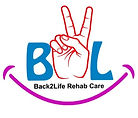Suffering from BACK PAIN at work? Here is what YOU can do about it
- b2lcare

- Oct 24, 2018
- 4 min read
Updated: Mar 20, 2022
It affects us all. No exceptions.
If you are stuck having to sit long hours at work or in flight or in car, you’re going to need to protect your back.
Whether it’s from sitting at work or from driving long distances, virtually all of us suffer from this painful condition.
It is important to understand that although you ‘feel‘ rested while in the seated position, your spine is NOT actually in a restful state or position. Sitting allows you to relax almost all of the muscles of your body except for the ones that keep you from leaning over to the side and
forward. The pressure on your lumbar discs is much too high in this position.
Don’t Ignore Your Pain
It is not safe to persevere through the pain and speed up the recovery with painkillers and muscle relaxants. These medications do have their value but are not without complications. If you find yourself treating your lost time from work this way, then you’re treating the symptoms and not the causes.
Some important practices can be followed to reduce your chances of injury and spasm while at work, thereby making your work hours much more productive and pain-free.
Muscles spasms seem to have a mind of their own. We can manage them well, but we are not very good at predicting or controlling them. We are also not very good at knowing when they will fully recover and become frustrated from lost time at work.
One important sign is when your butt muscles themselves (Gluteus) hurt.
Weak Gluteus = Back pain
The most important of the skeletal muscles in your body is your Gluteal muscles (yes, those are your butt muscles!The Gluteus maximus gives you the necessary power to push or to propel your body upward or forward. You need to keep this muscle active.📷
Your Gluteus Are Your Lifesaver.If you sit on them, you’ll lose them
Follow these important exercises while at work for your pain.
First, here are the benefits:
Easy
Requires little time
Can be done while sitting
Can be done in between driving breaks
Can be done in your spare time
Helps to correct your bad posture
Improves the way in which you sit
Helps both the lower back and the hips
encourages proper muscle reconditioning
reduces your reliance on medication
reduces your need for special chairs
reduces your need for back braces
Lunges are necessary for your back
One very important way to strengthen your GLUTEUS is by performing the lunge. Lunging both strengthens and maintains them. It’s one of the most recommended movements by practitioners because it is necessary.
Step 1: Lower your hips down into a squat position. Keep your feet shoulder width apart. Your thighs should be just above parallel to the floor. Place your hands on your hips.
📷
Step 2: Bring one leg back until the thigh is vertical to the floor. Do not allow your knee to touch the floor. Use your hands on your hips to adjust and maintain your hips level and facing forward. Your back should be straight and upright.
Step 3: Hold this position for 1-10 seconds.
Step 4: Slowly bring your rear leg to the forward squat position. Keep your thigh parallel to the floor.
Step 5: Hold this position for 1-10 seconds.
Step 6: Return to a standing position and relax.
Step 7: Repeat often.
Seated Lunge
Step 1: Sit upright with one leg and buttock fully ON the seat and the other leg and buttock suspended OFF of the seat. Keep both knees bent and feet flat.
📷
Step 2: With the unsupported leg, slowly slide it to the side and behind you until you are fully stretched out as comfortably as possible. Hold the chair rest or table for stability.
Step 3: Try to extend the leg behind you by contracting your thigh muscles and hold this position for 1 minute.
Step 4: Repeat this exercise with the other leg.
Let’s Start the Seated Leg to Chest exercise
Step 1: While seated, raise on knee up and bring the inner thigh up toward your chest. Use your hands to carefully assist in rotating the leg inward to your chest.
📷
Step 2: Hold for 2 minutes while keeping your back straight.
Step 3: Relax back down and repeat with the other leg.
Step 4: Repeat often.
Tip: Contract your abdominal firmly against your raised thigh and hold.
Standing Hip Shift
Step 1: Stand upright, raise one leg and hold it up unassisted. Allow the unsupported hip to drop.
📷
Step 2: Raise the elevated and unsupported side of the hip by flexing the standing hip. Raise in a slow and controlled fashion as high as possible. Your hip should be raised from below the level position to above level.
Step 3: Hold the contraction and keep your hip raised for 1-10 seconds.Step 4: Return to a rest position.
Step 5: Repeat with the other leg and hip.
Step 6: Repeat this entire exercise but now with a forward lean. Contract your abdominals and hold 1- 10 seconds.
This exercise will take many days before you will notice any changes in your hip mobility. Don’t quit early. See it through. It is probably one of the most important exercises here. If you need privacy, either tell everyone in the office to leave (kidding), or go on a quick break somewhere more suitable.

.
















Comments